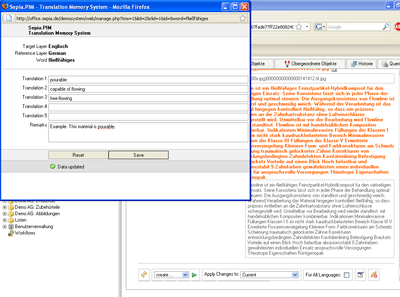Translation Memory
A Translation Memory(TM) System is a database for translations of terms and semantic units that were created by a human translator. The system stores what has been suggested and recorded by the human translator as an appropriate translation. Such a database is then often used as the basis for a simplified manual translation of similar content.
Alterra Translation Memory is a web-based module for Alterra PIM that allows multiple translators to work on a translation job via the Internet. Alterra PIM software (Product Information Management) is commonly used in international corporations. Details of the system:
- It is used via a web browser, making it especially interesting for large organisations operating from distributed locations.
- It does not require any editor like Word or Excel to edit the translations.
- It stores its information in an object database and can be used directly in combination with an OMS system.
- Interfaces to other systems are fairly easy to configure, as Sepia Alterra supports data exchange via XML.

Figure: Proposals for Translations in Alterra
Alterra Translation Memory as an add-on for Alterra PIM
In the following, we describe the use of Alterra Translation Memory as an add-on to Alterra PIM software. Within the PIM product database, the Translation Memory Module is used in combination with the configured language layers (levels). Translation Memory without Sepia Alterra The functionality is totally integrated into the existing translation process in Sepia Alterra PIM. This process usually looks as follows:
- A text is created in a base language.
- The text is assigned to a product.
- A translator selects a product and then changes to the target language.
- The translator can view the text in the base language parallel to the target language.
- The translator uses the displayed base language as the source for the translation.
- The translator saves the translated text in the target language.
This is the whole process without Alterra. Alterra Translation Memory as a module comes in at the point where the translator displays the base language as the source for his translation. Here, Alterra automatically provides the translator with proposals for their translation. In addition, the translator can even transfer individual text blocks or terms into the Translation Memory Module to make these translations available for future translation processes.
Translation Memory with Alterra TM
And this is what the process looks like with the use of Sepia Alterra:
- A text is created in a base language.
- The text is assigned to a product.
- A translator selects a product and then changes to the target language.
- The translator can view the text in the base language parallel to the target language.
- The translator selects individual words from the source language and saves and comments on their translation.
- The translator accepts proposed translations and includes them directly in the text of the target language.
- The translator accepts and includes whole passages from the translation proposed by the TM system.
- The translator saves the translated text in the target language.
For further translations, the translator or his colleagues can access and use the stored translation suggestions (see point 5).
Large savings potential for translations
The purpose of this approach is to save time that would be lost while looking up terminology in dictionaries or other resources – and not to forget: to improve the consistency of translations as the process avoids that the same terms are translated differently within a coherent text or body of texts.
The Alterra TM module is therefore a tool that greatly facilitates the translation within Alterra PIM. The translation process is significantly accelerated by the fact that terms and whole passages that are repeatedly used within the system must only be translated once. This approach results in statistically proven savings in the translation process of up to 80%.
Integration of Google Translate or other Translation Services
The Alterra Translation Memory module can be simply extended by an automatic web translation service. This service can offer translation proposals for translators which can correct the proposals of these services and finally save the correct version of the translation.
Go to Sepia Web2Print
Contact
Sepia GmbH & Co. KG
Ernst-Gnoss-Strasse 22
D-40219 Düsseldorf - Germany
Phone: +49 211 51 419 75
Phone alternative: +49 211 74 958 712 0
E-Mail: info@sepia.de
Looking for consultation or a web demo?
Get it here.
Movie: Typo3Connector
This is a translation test box for the english version.

